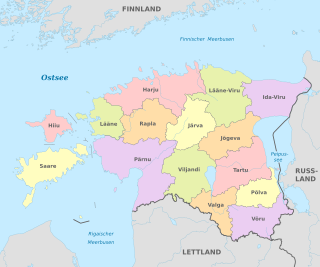Related Research Articles
The Northern Crusades or Baltic Crusades were Christian colonization and Christianization campaigns undertaken by Catholic Christian military orders and kingdoms, primarily against the pagan Baltic, Finnic and West Slavic peoples around the southern and eastern shores of the Baltic Sea, and to a lesser extent also against Orthodox Christian Slavs.

Counties are the state administrative subdivisions of Estonia. Estonian territory is composed of 15 counties, including 13 on the mainland and 2 on islands. County governments were abolished at the end of 2017, with their duties split between state authorities and local governments, and nowadays counties have no noteworthy independent competences. Counties are composed of municipalities of two types: urban municipalities and rural municipalities, which are by law required to cooperate in development of their county.

Saare County is one of 15 counties of Estonia. It consists of Saaremaa, the largest island of Estonia, and several smaller islands near it, most notably Muhu, Ruhnu, Abruka and Vilsandi. The county borders Lääne County to the east, Hiiu County to the north, and Latvia to the south. In 2022 Saare County had a population of 31,292, which was 2.4% of the population of Estonia.

The Livonian Chronicle of Henry offers a Latin narrative of events in Livonia and surrounding areas from 1180 to 1227. It was written ca. 1229 by a priest named Henry. Apart from the few references in the Primary Chronicle compiled in Kievan Rus' in the twelfth century, it is the oldest known written document about the history of Estonia and Latvia.

Caupo of Turaida, or Kaupo was a leader of the Finnic-speaking Livonian people in the beginning of the 13th century, in what is now part of Latvia and Estonia. He is sometimes called a 'King of Livonia', the Chronicle of Henry of Livonia refers to him as quasi rex, 'like a king'.
The Vironians were one of the Finnic tribes that later formed the Estonian nation.

The Vends were a Balto-Finnic people that lived between the 12th to 16th centuries in the area around the town of Wenden in present-day north-central Latvia.
Estonian mythology is a complex of myths belonging to the Estonian folk heritage and literary mythology. Information about the pre-Christian and medieval Estonian mythology is scattered in historical chronicles, travellers' accounts and in ecclesiastical registers. Systematic recordings of Estonian folklore started in the 19th century. Pre-Christian Estonian deities may have included a god known as Jumal or Taevataat in Estonian, corresponding to Jumala in Finnish, and Jumo in Mari.
Ugaunians or Ugannians, referred to as Chudes by the earliest Russian chronicles were historical Finnic people inhabiting the ancient southern Estonian Ugandi County (Latin:Ungannia) that is now Tartu, Põlva, Võru and Valga counties of Estonia.

Ugandi was an independent county between the east coast of Lake Võrtsjärv and west coast of Lake Pskov, bordered by Vaiga, Mõhu, Nurmekund, Sakala, Tālava, and The Principality of Pskov. Ugandi had an area of approximately 3000 hides. Ugandi corresponded roughly to the present Estonia's territory of Võru County, Põlva County and half of Tartu County and Valga County, as well as Petseri County.

The Duchy of Estonia, also known as Danish Estonia, was a direct dominion of the King of Denmark from 1219 until 1346 when it was sold to the Teutonic Order and became part of the Ordensstaat.
Vyachko of Koknese, also Vetseke of Kokenhusen was the ruler of the Principality of Koknese in present-day Latvia, a vassal of Polotsk, who unsuccessfully tried to establish himself as a local ruler first in Latvia and then in Estonia, and fought against the expansionism of the Livonian Knights at the turn of the 13th century.

Oeselians or Osilians is a historical name for the people who prior to the Northern Crusades in the 13th century lived in the Estonian island of Saaremaa (Ösel) — the Baltic Sea island was also referred as Oeselia or Osilia in written records dating from around that time. In Viking Age literature, the inhabitants were often included under the name "Vikings from Estonia". The earliest known use of the word in the (Latinised) form of "Oeselians" in writing was by Henry of Livonia in the 13th century. The inhabitants of Saaremaa (Ösel) are also mentioned in a number of historic written sources dating from the Estonian Viking Age.

The Livonian crusade refers to the various military Christianisation campaigns in medieval Livonia – in what is now Latvia and Estonia – during the Papal-sanctioned Northern Crusades in the 12–13th century. The Livonian crusade was conducted mostly by the Holy Roman Empire and the Kingdom of Denmark. It ended with the creation of Terra Mariana and the Danish duchy of Estonia. The lands on the eastern shores of the Baltic Sea were one of the last parts of Europe to be Christianised.

Ancient Estonia refers to a period covering History of Estonia from the middle of the 8th millennium BC until the conquest and subjugation of the local Finnic tribes in the first quarter of the 13th century during the Teutonic and Danish Northern Crusades.

Virumaa is a former independent county in Ancient Estonia. Now it is divided into Ida-Viru County or Eastern Vironia and Lääne-Viru County or Western Vironia. Vironians built many strongholds, like Tarwanpe and Agelinde.

The Battle of Valdevez took place at Arcos de Valdevez on the banks of the river Vez between the Kingdom of León and the Kingdom of Portugal in the summer of 1140 or 1141. It is one of only two pitched battles that Alfonso VII of León is known to have fought, and the only of the two not coincident with a siege. His opponent at Valdevez was his cousin Afonso I of Portugal. An armistice signed after the battle eventually became the Treaty of Zamora (1143), and ended Portugal's first war of independence. The area of the battle became known as the Veiga or Campo da Matança, the "field of killing".
The siege of Tartu took place in 1224 and resulted in the fall of the last major center of Estonian resistance in the mainland provinces to the Christian conquest of Estonia.

Terra Mariana was the official name for Medieval Livonia or Old Livonia. It was formed in the aftermath of the Livonian Crusade, and its territories were composed of present-day Estonia and Latvia. It was established on 2 February 1207, as a principality of the Holy Roman Empire, but lost this status in 1215 when Pope Innocent III proclaimed it as directly subject to the Holy See.

The Valjala Stronghold was a major ringfort on the island of Saaremaa in Estonia. Established in the 12th century, at the time it was the most important Oeselian stronghold. Its surrender in 1227 finalized the crusader conquest of Estonia.
References
- ↑ The Esthonian Review, vol 1. Esthonian Review Office. 1919. p. 145.
- ↑ http://www.folklore.ee/folklore/vol26/sutrop.pdf Taarapita – the Great God of the Oeselians. Article by Urmas Sutrop
- ↑ Lennart Meri, (1984). "Hõbevalgem"
- ↑ Heinrici Chronicon Livoniae = Henriku Liivimaa kroonika. 1982. Traductionem paravit Richard Kleis, Enn Tarvel textum curavit et commentatus est. Tõlkinud Richard Kleis, toimetanud ja kommenteerinud Enn Tarvel. Eesti Raamat, Revalie = Tallinn, XXIV 5, p 216
- ↑ Heinrici Chronicon Livoniae, XXX 4, p 268.
- ↑ Heinrici Chronicon Livoniae, XXX 5, p 270
- ↑ Heinrici Chronicon Livoniae, XXX 5, pp 270, 272
- ↑ Heinrici Chronicon Livoniae, XXX 6, p 272